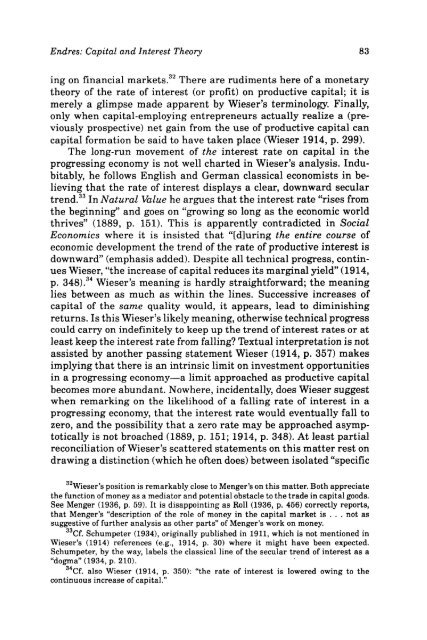Review of Austrian Economics - The Ludwig von Mises Institute
Review of Austrian Economics - The Ludwig von Mises Institute
Review of Austrian Economics - The Ludwig von Mises Institute
You also want an ePaper? Increase the reach of your titles
YUMPU automatically turns print PDFs into web optimized ePapers that Google loves.
Endres: Capital and Interest <strong>The</strong>ory 83<br />
ing on financial markets. 32 <strong>The</strong>re are rudiments here <strong>of</strong> a monetary<br />
theory <strong>of</strong> the rate <strong>of</strong> interest (or pr<strong>of</strong>it) on productive capital; it is<br />
merely a glimpse made apparent by Wieser's terminology. Finally,<br />
only when capital-employing entrepreneurs actually realize a (previously<br />
prospective) net gain from the use <strong>of</strong> productive capital can<br />
capital formation be said to have taken place (Wieser 1914, p. 299).<br />
<strong>The</strong> long-run movement <strong>of</strong> the interest rate on capital in the<br />
progressing economy is not well charted in Wieser's analysis. Indubitably,<br />
he follows English and German classical economists in believing<br />
that the rate <strong>of</strong> interest displays a clear, downward secular<br />
trend. 33 In Natural Value he argues that the interest rate "rises from<br />
the beginning" and goes on "growing so long as the economic world<br />
thrives" (1889, p. 151). This is apparently contradicted in Social<br />
<strong>Economics</strong> where it is insisted that "[d]uring the entire course <strong>of</strong><br />
economic development the trend <strong>of</strong> the rate <strong>of</strong> productive interest is<br />
downward" (emphasis added). Despite all technical progress, continues<br />
Wieser, "the increase <strong>of</strong> capital reduces its marginal yield" (1914,<br />
p. 348). 34 Wieser's meaning is hardly straightforward; the meaning<br />
lies between as much as within the lines. Successive increases <strong>of</strong><br />
capital <strong>of</strong> the same quality would, it appears, lead to diminishing<br />
returns. Is this Wieser's likely meaning, otherwise technical progress<br />
could carry on indefinitely to keep up the trend <strong>of</strong> interest rates or at<br />
least keep the interest rate from falling? Textual interpretation is not<br />
assisted by another passing statement Wieser (1914, p. 357) makes<br />
implying that there is an intrinsic limit on investment opportunities<br />
in a progressing economy—a limit approached as productive capital<br />
becomes more abundant. Nowhere, incidentally, does Wieser suggest<br />
when remarking on the likelihood <strong>of</strong> a falling rate <strong>of</strong> interest in a<br />
progressing economy, that the interest rate would eventually fall to<br />
zero, and the possibility that a zero rate may be approached asymptotically<br />
is not broached (1889, p. 151; 1914, p. 348). At least partial<br />
reconciliation <strong>of</strong> Wieser's scattered statements on this matter rest on<br />
drawing a distinction (which he <strong>of</strong>ten does) between isolated "specific<br />
32 Wieser's position is remarkably close to Menger's on this matter. Both appreciate<br />
the function <strong>of</strong> money as a mediator and potential obstacle to the trade in capital goods.<br />
See Menger (1936, p. 59). It is disappointing as Roll (1936, p. 456) correctly reports,<br />
that Menger's "description <strong>of</strong> the role <strong>of</strong> money in the capital market is . . . not as<br />
suggestive <strong>of</strong> further analysis as other parts" <strong>of</strong> Menger's work on money.<br />
33 Cf. Schumpeter (1934), originally published in 1911, which is not mentioned in<br />
Wieser's (1914) references (e.g., 1914, p. 30) where it might have been expected.<br />
Schumpeter, by the way, labels the classical line <strong>of</strong> the secular trend <strong>of</strong> interest as a<br />
"dogma" (1934, p. 210).<br />
34 Cf. also Wieser (1914, p. 350): "the rate <strong>of</strong> interest is lowered owing to the<br />
continuous increase <strong>of</strong> capital."

















